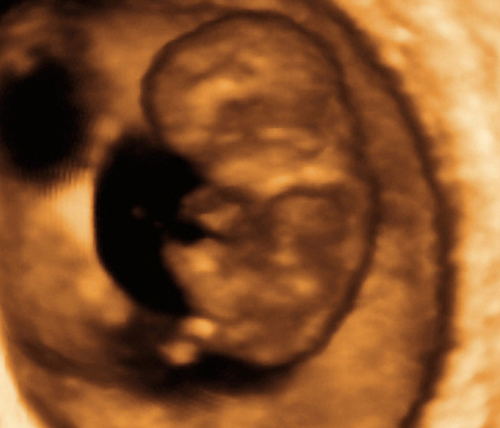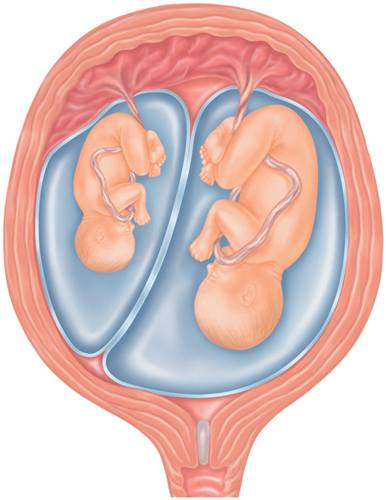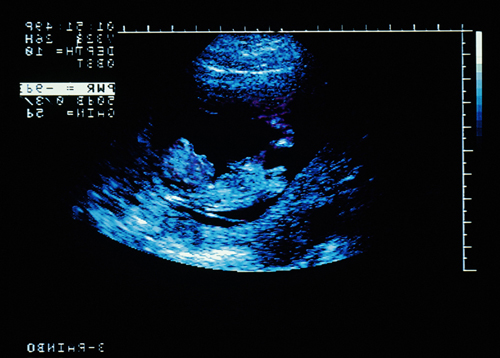You are 10 Weeks and 2 Days 208 days to go…
Will it be a boy or a girl? Significant changes are taking place that enable your baby’s sexual organs to develop.
Your baby today
The baby’s head is just under half the length of his body. His
limbs are still relatively short but the hands and feet can look quite
big. Early basic trunk and limb movements are taking place but it’s too
early to feel them at this stage.

Hormones are influencing your unborn baby’s development
and the ovaries or testes now begin to form. The testes will gradually
descend but there structural development won’t be complete until your
child hits puberty. The ovary will produce eggs but these will remain in the early stages of development.
A minute genital tube
forms the external genitalia but each sex appears the same at this
stage. This is not entirely surprising since the phallus is only 0.09 in
(2.5 mm) long. Your baby’s bladder and rectum have now separated. The
kidneys will take some time to fully develop: two buds grow up from the
bladder to the tissue that will become the kidneys, one on each side.
These so-called uteric buds form the ureters—the tubes that transport
urine from the kidney to the bladder. The ureteric bud must successfully
fuse with the kidney tissue in the pelvis. As the ureteric buds expands
upward, the early kidneys developing in the pelvis will move upward to
lie in the abdomen.
… Doctor
| Q: |
I have hay fever. Can I take antihistamines?
|
| A: |
The potential effects of taking antihistamines in pregnancy
aren’t known, so it’s best to err on the side of caution and not take
them. However, if your symptoms are very severe, see your doctor since
there is one antihistamine available by prescription that can be taken
during pregnancy.
|
… Twins
A shared support system
Nonidentical twins are always in separate amniotic sacs
with a placenta each. If your babies are identical (from one fertilized
egg) they may share the same placenta and/or amniotic sac, with a
single membrane called the chorion surrounding them. These are known as
monochorionic twins and will require greater monitoring. The arrangement
of the placenta and amniotic sacs can be analyzed on an ultrasound
scan.
When twins share a
placenta, a blood vessel directly connects them. This can cause one twin
to receive too much blood, which can cause heart problems; the other
twin will get too little blood and not grow at the correct rate. This is
called twin-to-twin transfusion and happens in about 10–15 percent of
monochorionic pregnancies. The imbalance can sometimes be corrected by
draining amniotic fluid from around the twin with the greater blood
supply, or by using laser treatment to seal off some blood vessels in
the placenta. An early delivery may be necessary.

You are 10 Weeks and 3 Days 207 days to go…
You may begin to notice some discomfort around your pelvis as your body begins to accommodate your growing uterus.
Your baby today
This color 2D ultrasound scan shows a baby lying on its back
with its head to the right. This is the ideal position when measuring
the crown (head) to rump (bottom) length to accurately date the
pregnancy: it simply measures in a straight line.

Having a few minor aches and pains during pregnancy
is nothing to be concerned about. They occur because the ligaments and
muscles of your pelvis are stretching to fit your ever-growing uterus.
This can cause some discomfort but should be manageable. If the pain
you’re experiencing does become crampy, like period pain, and there is
any bleeding, or if the pain becomes very severe and constant, then you
should go to the doctor or the hospital to be checked. You will be
examined to rule out a miscarriage or ectopic pregnancy.
… Nutritionist
| Q: |
I’m allergic to dairy products. What can I eat to make sure my baby gets the nutrients these provide?
|
| A: |
Dairy products are an excellent source of protein, calcium
(which is required for the development of your baby’s teeth and bones),
some B vitamins, and a little iron. And milk contains vitamins A and D.
Eat foods that provide the same nutrients:
For calcium: leafy green vegetables, particularly broccoli and kale; fish with soft, edible bones, such as salmon (canned is fine), whitebait, and sardines; calcium-fortified soy milk. For vitamin A:
brightly colored vegetables, meats, eggs, and liver. Although most
nutritionists do not recommend liver during pregnancy, if you aren’t
getting much vitamin A in your diet, a little will not harm. For vitamin D: eggs. Vitamin D is also found in most fish. For vitamin E:
eggs, canned salmon, fortified orange juice and cereals, and fatty
fish. As long as you’re getting plenty of other sources of these key
nutrients, your baby’s health will not be adversely affected.
|
… Safety
Bon voyage
Whether you’re going on vacation or on a business trip, it’s important to be prepared:
Check you’re healthy enough to travel—speak to your doctor.
Find out whether you need any vaccinations and discuss these with your doctor . It’s advisable to avoid traveling to areas where there is a high risk of disease while you’re pregnant if at all possible.
Get travel insurance and make sure it covers you during pregnancy.
Carry your prenatal records with you at all times and stay within reach of medical help.
Don’t stay seated for long periods in transit and stay hydrated. Wear support socks to reduce the risk of DVT .
Wear adequate sun protection if you’re going to a hot climate.
Be careful about what you eat and drink bottled water.
